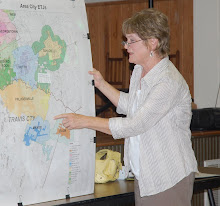MORE BLOWS AGAINST THE CORRIDOR
This week, more of the building blocks enabling the Trans-Texas Corridor, specifically TTC-35, have been destroyed. Previously, in the special session, legislators killed the funding mechanism for the Corridor—the Comprehensive Development Agreements (CDA) with private companies. Also earlier this year, TxDOT announced it would not proceed with the overall Corridor plan and would consider it segment by segment. Now, TTC-35 has been terminated in two different ways.
CINTRA/ZACHRY CONTRACT CANCELED
First, TxDOT has canceled the contract with Cintra, the Spanish corporation, and its partner Zachry to build TTC-35. Cintra/Zachry had a CDA with TxDOT to plan and build TTC-35. In the special session, the overall CDA process was done away with, and now Cintra’s specific CDA has been canceled. Cintra has produced a plan, has been paid millions for planning, and may be paid more millions for the state to extricate itself from the complicated contracts negotiated by Giuliani Bracewell (the law firm of Perry pal Rudy Giuliani). However, Cintra will not do any building on TTC-35 except for the two southern segments of SH 130 that are underway and which will now be considered SH 130, not part of TTC-35.
NO-BUILD OPTION/NO ACTION ALTERNATIVE
Secondly, the environmental process on TTC-35 ends with a recommendation by TxDOT to the Federal Highway Administration to do nothing—called the “no-build option” or the “no action alternative.”
TxDOT, using taxpayer funds, spent years of time and energy and millions of dollars on TTC-35, reportedly $131 million for planning and environmental work. In addition to all of this wasted effort and money on the part of TxDOT, there are the untold volunteer hours, contributions, and worry on the part of residents in the threatened areas and supporters around the state.
The Draft Environmental Impact Statement (EIS), the 4,000-page document showing a general TTC-35 route, was released in 2006, and the Final EIS was scheduled to be released in 2007. TxDOT officials said that the decision not to build TTC-35 was in response to comments from citizens received during the environmental process. Of course, during the entire TTC-35 ordeal, TxDOT has not cared at all about citizens’ opinions.
WHAT REALLY KILLED TTC-35--
COMMUNITY AND POLITICAL PRESSURE IN THE LEGISLATURE
Even though citizen comments per se did not affect TxDOT, it was important that tens of thousands of residents attended the various levels of meetings and hearings, spoke against TTC-35, signed petitions, and submitted written comments. This effort formed the foundation of community organizations working against the Corridor and the process of influencing legislators and electing new legislators.
This, in turn, resulted in the legislature gradually turning against the Corridor and eliminating the Comprehensive Development Agreement tool.
EASTERN CENTRAL TEXAS SUB-REGIONAL PLANNING COMMISSION (ECTSRPC)
The reason that TxDOT and the Federal Highway Administration finally had no way to continue with the TTC-35 EIS was the action of the ECTSRPC in Bell and Milam counties. Five small towns and their associated school districts formed their Sub-Regional Planning Commission, and by state law, TxDOT was compelled to “coordinate” with their Commission. This meant that TxDOT had to take into account what the ECTSRPC citizens wanted and cover all required issues in the EIS process. TxDOT had not done this, meaning that the EIS was not legal and could not be recognized as legal by the Federal Highway Administration.
The ECTSRPC announced: “Selecting that option [no build] was exactly what the Eastern Central Texas Sub-Regional Planning Commission (ECTSRPC) forced TxDOT into choosing. . . . The planning commission began a series of what is called coordination meetings in the fall of 2007, by utilizing a little known state statute that forced the behemoth agency to come to Holland, Texas. . . . TxDOT came to Holland on three different occasions where they were asked to explain why they were going to destroy five towns and their school districts with a 1,200 foot-wide, 146 acre per mile toll road.
“‘Through coordination, we forced them to our table and then we used the federal NEPA (National Environmental Policy Act) statute to box them in a legal corner out of which they could not escape,’ stated Ralph Snyder, a local Holland businessman and board member of the ECTSRPC. ‘That's what forced TxDOT to recommend 'No Build' to the Federal Highway Administration because we had shown how TxDOT, as the agent of the federal government, had violated the federal statute in at least 29 ways,’ Snyder continued.
“Fred Grant, president of American Stewards of Liberty, is the originator of the coordination strategy that brought TxDOT to their knees.”
FUTURE OF TTC-35 AND THE CORRIDOR CONCEPT
Some more time and paperwork is required to complete the TTC-35 EIS process, at the end of which the Federal Highway Administration will issue its Record of Decision approving the “No Action Alternative.” This is what so many of us asked in our comments, never thinking it would actually happen--it hardly ever happens--but now it is the final result!
Even though the Legislature has gradually turned against the Corridor concept, the legislation enabling it is still on the books. In addition, the Trans-Texas Corridor began as Gov. Perry’s “vision,” and he has never renounced it. We have to remain vigilant as long as the Corridor statute has not been repealed, and as long as Perry or anyone else who supports the concept is in the governor’s office.
Friday, October 9, 2009
Corridor--especially TTC-35--continues to be killed
Labels:
Cintra,
ECTSRPC,
Environmental Impact Statement,
FHWA,
Rick Perry,
Trans-Texas Corridor,
TTC-35,
TxDOT
Subscribe to:
Post Comments (Atom)

No comments:
Post a Comment